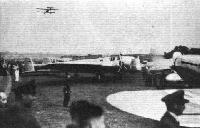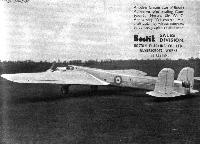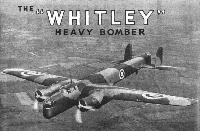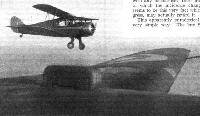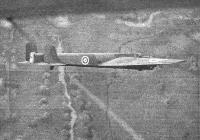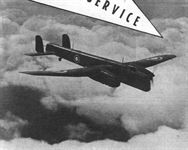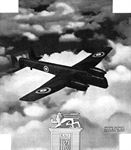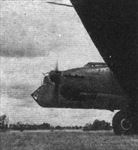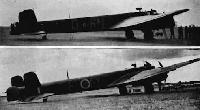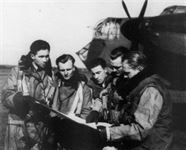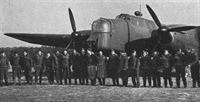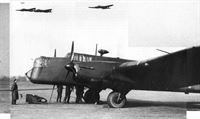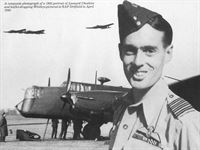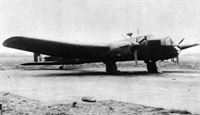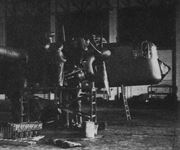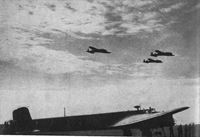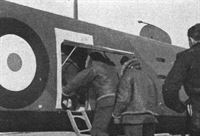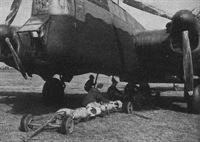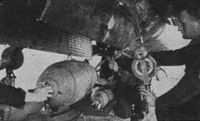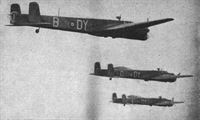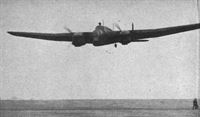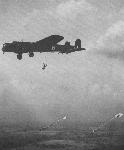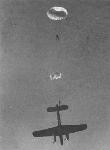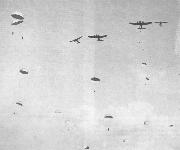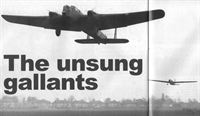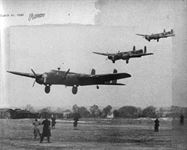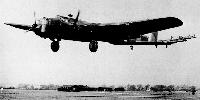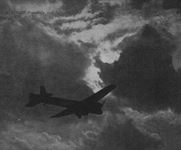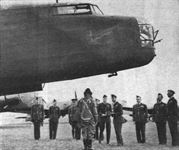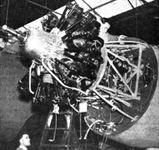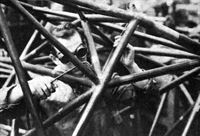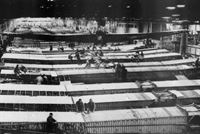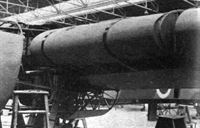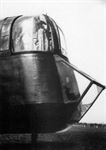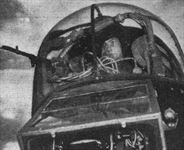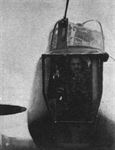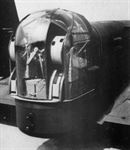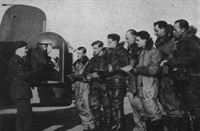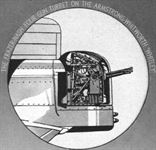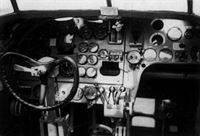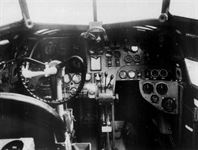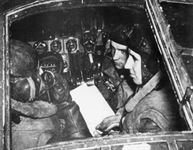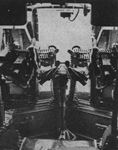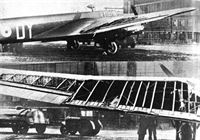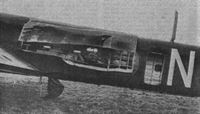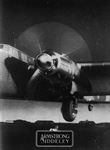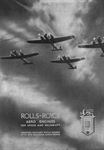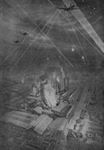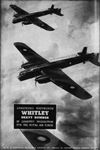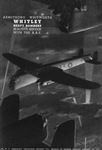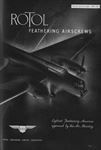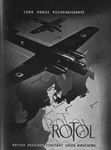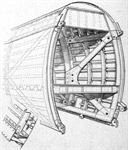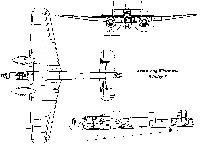
Варианты
- Armstrong Whitworth - Whitley / A.W.38 - 1936 - Великобритания
- Armstrong Whitworth - Whitley GR.VII / A.W.38 - 1941 - Великобритания
Whitley / A.W.38
Средний бомбардировщик, двухмоторный цельнометаллический моноплан с двухкилевым оперением и убирающимся шасси с хвостовым колесом. Экипаж 5 человек. Спроектирован в КБ фирмы "Армстронг-Уитворт" под руководством Дж.Ллойда. Опытный образец самолета впервые поднялся в воздух 17 марта 1936 г. Серийное производство на заводе "Армстронг-Уитворт" в Ковентри началось в феврале 1937 г. Всего выпущено 1824 экз., из них 1678 бомбардировщиков. "Уитли" поступил на вооружение ВВС Великобритании в марте 1937 г.
Основные серийные модификации как бомбардировщика:
- "Уитли" I с моторами "Тайгер" XI, вооружение 2x7,69, бомбы до 680 кг;
- "Уитли" II с моторами "Тайгер" VIII, вооружение 4x7,69, бомбы до 1590 кг;
- "Уитли" III с увеличенным бомбоотсеком, бомбы до 2500 кг;
- "Уитли" IV с моторами "Мерлин" IV, увеличенный запас горючего, бомбы до 3200 кг;
- "Уитли" IVA с моторами "Мерлин" X;
- "Уитли" V с вооружением 5x7,69, антиобледенительной системой.
Существовали также противолодочные и транспортные варианты.
С сентября 1939 г. "Уитли" сбрасывали листовки над Германией, с марта 1940 г. осуществляли ночные бомбардировки (в широких масштабах - с мая), в т.ч. в августе - налет на Берлин. В июне 1940 г. провели бомбежку Генуи и Турина. Последний массированный налет с участием "Уитли" состоялся в апреле 1942 г., после чего самолеты передали в учебные подразделения. Однако весной и летом их вновь привлекли к налетам на Кёльн, Эссен, Бремен и другие города Германии. "Уитли" был снят с производства весной 1943 г. Как учебный и транспортный самолет использовался до 1945 г.
"Уитли" V||
Размах:||25,6 м
Длина:||22,1 м
Моторы, количество х мощность:||2x1145 л.с.
Взлетная масса, максимальная:||15209 кг
Максимальная скорость:||370 км/ч
Практический потолок:||7925 м
Дальность:||2415 км
Описание:
- Whitley / A.W.38
- Jane's Encyclopedia of Aviation
- Flight, November 1939
Britain's Military Aircraft
Фотографии
-
Aeroplane Monthly 1982-10 / R.Williams - Armstrong Whitworth's night bomber (3)
Регистрационный номер: K8945 Whitley III of 102 Sqn.
-
АвиаМастер 1999-05 / В.Котельников - Бомбардировщик, летавший носом вниз /Монография/
Регистрационный номер: N1428 Whitley B.V, 58-я эскадрилья RAF, июнь 1940г.
-
АвиаМастер 1999-05 / В.Котельников - Бомбардировщик, летавший носом вниз /Монография/
Регистрационный номер: T4131 Whitley B.V, 78-я эскадрилья RAF, конец 1940г.
-
Мировая Авиация 121
Регистрационный номер: Z6640 [3] Armstrong Whitworth Whitley. Whitley Mk V из 78-й эскадрильи, дислоцированной в Крофте, графство Йоркшир, и принимавшей участие в ночных налетах с первых дней войны.
-
АвиаМастер 1999-05 / В.Котельников - Бомбардировщик, летавший носом вниз /Монография/
Регистрационный номер: BD661 [2] Whitley B.V, буксировщик десантных планеров, 1943г.
-
АвиаМастер 1999-05 / В.Котельников - Бомбардировщик, летавший носом вниз /Монография/
Регистрационный номер: G-AGDY [2], BD386 [2] Whitley B.V(Transport), авиакомпания BOAC, 1942г.
-
Aeroplane Monthly 1982-10 / R.Williams - Armstrong Whitworth's night bomber (3)
Регистрационный номер: G-AGEA Whitley V transport of BOAC
-
Aeroplane Monthly 2000-02 / P.Jarrett - Historic colour. Armstrong Whitworth Whitley /Pre-WW2 colour photography/
Регистрационный номер: K9018 The Whitley IV depicted here, K9018, served with No 10 Sqn and is seen at Biggin Hill in 1939. The squadron received its first example in March 1937 and operated the Mk I until May 1939, before moving on to the Mk IV and later still the Whitley V. This particular aircraft went missing over the North Sea on November 4, 1939. The photograph was taken by Sqn Ldr H.H. Chapman, who served with 3 Sqn at Kenley.
-
Air Pictorial 1956-12 / Lintonian - The Whitley story (1)
Регистрационный номер: K4586 [13] The first prototype Whitley I, K4586. It later became a ground instructional aircraft serialled 7070M.
-
Flight 1936-03 / Flight
Регистрационный номер: K4586 [13] A NEW "HEAVY." The Armstrong-Whitworth Whitley (two Tiger engines).
-
Flight 1936-11 / Flight
Регистрационный номер: K4586 [13] The prototype Whitley, K4586, seen during its first public appearance at the RAF Display at Hendon on June 27, 1936.
With two 795 h.p. Tiger IXs the new Armstrong Whitworth Whitley heavy bomber has a fine performance for a machine of its size. -
АвиаМастер 1999-05 / В.Котельников - Бомбардировщик, летавший носом вниз /Монография/
Регистрационный номер: K4586 [13] Первый опытный экземпляр "Уитли". На самолете установлены пулеметные турели раннего образца с педальным приводом. Снимок 1936г.
METAL-CLAD, Stressed skin, V.P. airscrew, flaps and retractable undercarriage are features of the new A. W. Whitley. -
Flight 1936-06 / Flight Advertisements
Регистрационный номер: K4586 [13] -
Flight 1937-03 / Flight Advertisements
Регистрационный номер: K4586 [13] -
Aeroplane Monthly 1982-08 / R.Williams - Armstrong Whitworth's night bomber (1)
Регистрационный номер: K4586 [13] The prototype Whitley, K4586, showing well the two 795 h.p. supercharged Armstrong Whitworth Tiger IX engines and the newly introduced three-blade two position de Havilland propellers.
-
Flight 1936-06 / Flight
Регистрационный номер: K4586 [13] A HENDON DEBUTANT: The Armstrong Whitworth Whitley heavy bomber is likely to make its first public appearance at the R.A.F. Display on June 27. Its engines are two 790/880 Tiger IXs.
-
Aeroplane Monthly 1982-08 / R.Williams - Armstrong Whitworth's night bomber (1)
Регистрационный номер: K4586 [13] The prototype Whitley, K4586, was relegated to an instructional airframe as 7070M after test work was completed.
-
Flight 1936-07 / Flight
Регистрационный номер: K4586 [13] The leisurely passage of the ancient Farman over the new types park. In the foreground the Merlin in the Hawker F.36/34 is being run up. The Whitley heavy bomber is seen in the centre.
Другие самолёты на фотографии: Farman Farman-30/40 - Франция - 1915Hawker Hurricane - Великобритания - 1935
-
Aeroplane Monthly 1984-11 / L.Coombs - The expanding years 1936-1939 (1)
Регистрационный номер: K4586 [13] One wonders if anyone who walked past the New Types Park at the 1936 Hendon RAF Pageant realised the significance of Nos 1 and 2, the Hawker Hurricane and Supermarine Spitfire prototypes. Just visible too is the tail of the Armstrong Whitworth Whitley, destined to become one of the mainstays of Bomber Command during the early part of the war, three years away.
Другие самолёты на фотографии: Hawker Hurricane - Великобритания - 1935Supermarine Spitfire - Великобритания - 1936Vickers Venom - Великобритания - 1936
-
Aeroplane Monthly 1974-09 / ??? - Hendon Pageantry 1920-37
Регистрационный номер: K4586 [13] The shape of wings to come. Monoplanes fill the new types park at the 1936 pageant.
Другие самолёты на фотографии: Fairey Battle - Великобритания - 1936Supermarine Spitfire - Великобритания - 1936Vickers Venom - Великобритания - 1936Vickers Wellington / Type 271 - Великобритания - 1936Westland Lysander - Великобритания - 1936
-
Flight 1936-07 / Flight Advertisements
Регистрационный номер: K4586 [13] -
Flight 1938-03 / Flight Advertisements
Britain's biggest air liner is equipped with Siddeley engines cowled with fairing rings by Northern Aircraft & Engineering Products, Ltd. In the background of the photograph is the “Whitley” bomber, also fitted with our cowlings.
Другие самолёты на фотографии: Armstrong Whitworth Ensign / A.W.27 - Великобритания - 1938
-
Flight 1936-07 / Flight
It is obvious that the Whitley is related to the A.W.23 bomber transport.
-
Flight 1937-06 / Flight
Регистрационный номер: K7191 [6] -
Flight 1937-10 / Flight
Регистрационный номер: K7211 [4] -
Flight 1939-05 / Flight
Регистрационный номер: K7211 [4] -
Aeroplane Monthly 1982-08 / R.Williams - Armstrong Whitworth's night bomber (1)
Регистрационный номер: K7222 [2] Whitley II K7222 with turret positions faired over.
-
Aeroplane Monthly 1982-08 / R.Williams - Armstrong Whitworth's night bomber (1)
Регистрационный номер: K7211 [4] This view of the Whitley I K7211 shows the wide chord wings to advantage. This Whitley became one of the three prototype Whitley IVs and was re-engined with Rolls-Royce Merlins. K7211 flew with Nos 58 and 10 Sqns before being lost in the English Channel on January 23, 1939.
-
Flight 1937-10 / Flight
Регистрационный номер: K7211 [4] -
Flight 1938-05 / Flight Advertisements
Регистрационный номер: K7222 [2] The sixth production Whitley 2, K7222, here seen before installation of gun turrets.
-
Aeroplane Monthly 1982-08 / R.Williams - Armstrong Whitworth's night bomber (1)
Регистрационный номер: K7209 [4] Whitley I K7209 later became one of three Whitley IV prototypes. Early Whitleys were delivered minus nose and tail turrets, though most aircraft received these rather necessary items at a later date.
-
Jane's All the World Aircraft 1938 / 03 - All the world's aeroplanes
Регистрационный номер: K7209 [4] The Armstrong Whitworth "Whitley" Heavy Bomber (two Armstrong Siddeley "Tiger" engines).
-
Air Pictorial 1956-12 / Lintonian - The Whitley story (1)
Регистрационный номер: K7191 [6] The Armstrong Whitworth Whitley is a very sound and well-defended type in the heavier category
K7191, the ninth production Whitley I. Note the absence of dihedral on the outer wing panels. -
Flight 1938-05 / Flight
Регистрационный номер: K7191 [6] The Armstrong-Whitworth Whitley (two Siddeley Tigers)
-
Aeroplane Monthly 1982-08 / R.Williams - Armstrong Whitworth's night bomber (1)
Регистрационный номер: K7191 [6] Whitley I K7191, from the initial production batch, served with Nos 10 and 166 Sqns.
-
Flight 1937-06 / Flight Advertisements
Регистрационный номер: K7191 [6] -
Aeroplane Monthly 1985-02 / L.Coombs - The expanding years 1936-1939 (4)
Mainstay of Bomber Command was the Whitley, which first entered service in March 1937 with 10 Sqn.
-
Flight 1937-06 / Flight
Регистрационный номер: K7183 -
Flight 1937-06 / Flight
The Armstrong Whitworth Whitley is a heavy bomber with two Siddeley Tiger engines, which, in later models, have two-speed superchargers
-
Flight 1937-05 / Flight
HIGH SPEED, LONG RANGE, HEAVY LOAD: The Armstrong Whitworth Whitley, ordered in large quantities for the R.A.F. The engines of this machine, which Flt. Lt. Turner-Hughes recently flew for Flight's photographer, are at present 795 h.p. Siddeley Tiger IXs, and D.H. v.p. airscrews are fitted.
-
Мировая Авиация 78
Первыми серийными машинами Whitley были самолеты версии Mk I со звездообразными моторами Armstrong Siddeley Tiger IX мощностью 810 л.с.(604 кВт).
Один из первых серийных "Уитли" в период заводских испытаний. На самолет уже нанесен военный камуфляж и опознавательные знаки, но еще нет буквенных идентификационных кодов. Снимок 1938г. -
Flight 1937-06 / Flight Advertisements
ARMSTRONG WHITWORTH "WHITLEY" Two 790 h.p. Armstrong Siddeley "Tiger" engines
-
Flight 1938-05 / Flight
ARMSTRONG WHITWORTH WHITLEY II and III: Bomber (two Tiger VIII engines 760 h.p. each at 12,750ft.); span, 84ft.; gross weight, 21,660 lb.; max. speed, 215 m.p.h. at 15,000ft.
-
Flight 1937-05 / Flight
MAN-MADE MIMICRY: The A.W. Whitley, with the new camouflage scheme, melts into the landscape.
-
Jane's All the World Aircraft 1938 / 03 - All the world's aeroplanes
Регистрационный номер: K7191 [6] The Armstrong Whitworth "Whitley" Heavy Bomber (two Armstrong Siddeley "Tiger" engines).
-
Flight 1937-10 / Flight
TAKER - AND TAKEN: This snapshot was taken from an Armstrong Whitworth Whitley. In the Avro Commodore, flown by Flt. Lt. Reynell, is Flight's chief photographer, and they are just manoeuvring into position to secure the striking close-up picture.
Другие самолёты на фотографии: Avro Commodore / Type 641 - Великобритания - 1934
-
Flight 1940-03 / Flight
AT CLOSE RANGE: An Armstrong Whitworth Whitley heavy bomber photographed from a machine flying close alongside. The pilot of the Whitley was F/O. E. S. Greenwood, the assistant A.W. test pilot.
An early Whitley photographed from an Avro Commodore. There was a distinct lifting of the wing tip when it approached close to that of the Whitley.Другие самолёты на фотографии: Avro Commodore / Type 641 - Великобритания - 1934
-
Flight 1937-11 / Flight
Another view of the echelon, taken from in front. This formation is less difficult in twin-engined aircraft than in single-engined types, where the pilot seldom has such a good view forward and down.
-
Flight 1937-11 / Flight
An echelon of four Whitleys. Note the almost-retracted wheels.
-
Flight 1937-05 / Flight
ON HER BEAM ENDS: Flt. Lt. Turner-Hughes demonstrates the manoeuvrability of the Armstrong-Whitworth Whitley heavy bomber. It. can be seen that the camera was aimed almost vertically at the ground.
-
Flight 1936-07 / Flight
The Armstrong Whitworth Whitley, with two Siddeley Tiger engines, is in the heavy bomber class and of modern design.
-
АвиаМастер 1999-05 / В.Котельников - Бомбардировщик, летавший носом вниз /Монография/
Регистрационный номер: K7188 "Уитли" I из состава 10-й бомбардировочной эскадрильи.
-
Aeroplane Monthly 1982-12 / Skywriters
Регистрационный номер: K8947 The first aircraft had not been with the squadron a week before station workshops were called upon to make a set of 6ft ladders to serve this entry point. The photograph of a visiting MkIII, K8947 at Linton in early 1939 shows both entry ladders in position. This aircraft was a rarity at the time as all three turrets were fitted and the ventral is seen drooping a little.
-
Flight 1937-06 / Flight
Регистрационный номер: K7189 View of the Armstrong Whitworth Whitley which show its general proportions and the gun turrets in the nose.
-
Flight 1937-11 / Flight
An impressive line-up of some of the Whitleys of No. 10 B.S. on Dishforth Aerodrome.
-
Flight 1937-11 / Flight
The pilots, officers and airmen, of No. 10 (B) Squadron: Wing Comdr. S. Graham, M.C., the CO., has his hands crossed in front. On either side are his two flight commanders, Sqn. Ldr. T. S. Horry, D.F.C., A.F.C., on his right, and Sqn. Ldr. E. B. Steedman on his left.
-
Flight 1937-11 / Flight
Some of the airmen of No. 10 B.S. Warrant Officer A. C. Townsend, sitting in the centre of the front row, wears an observer's wing on his tunic
-
Aeroplane Monthly 1982-09 / R.Williams - Armstrong Whitworth's night bomber (2)
THREE MEN AND A DOG ... The A.W. test team which put the Whitley through its paces for Flight's photographer (left to right): F/O. E. S. Greenwood, Flt. Lt. C. K. Turner-Hughes, and Flt. Lt. R. C. Reynell. To finish the quotation would cast most unjust aspersions on the Whitley's undercarriage.
-
Aeroplane Monthly 1982-09 / R.Williams - Armstrong Whitworth's night bomber (2)
Регистрационный номер: K7243 Whitley II K7243 with Armstrong Siddeley Deerhound 21-cylinder three-row radial engines installed.
-
Air Enthusiast 1972-03 / Talkback
The Deerhound-engined Whitley in the test hangar at Badington.
-
Air Enthusiast 1972-03 / Talkback
The Deerhound installation in the Whitley.
-
Air Pictorial 1957-01 / Lintonian - The Whitley story (2)
A hitherto unpublished photograph of the Armstrong Siddeley Deerhound engine.
-
Aeroplane Monthly 1982-09 / R.Williams - Armstrong Whitworth's night bomber (2)
Регистрационный номер: K7208 [3] Whitley I K7208, the first of the type to be fitted with Merlin engines.
-
АвиаМастер 1999-05 / В.Котельников - Бомбардировщик, летавший носом вниз /Монография/
Первый прототип "Уитли" с двигателями "Мерлин".
-
Jane's All the World Aircraft 1938 / 03 - All the world's aeroplanes
The Armstrong Whitworth "Whitley" Mk.IV Heavy Bomber (two Rolls-Royce "Merlin" engines).
-
Flight 1938-03 / Flight
Регистрационный номер: K7209 [4] MERLIN-POWERED: An Armstrong Whitworth Whitley heavy bomber fitted experimentally with two Rolls-Royce Merlin engines. The installations are graced with all the latest advances, including ejector-type exhaust pipes. It may be that the engines are Merlin Xs, which give 1,040 h.p. at 2,500ft. and 965 h.p. at 13,250ft. “Maximum” figures are somewhat higher.
Fitted with Merlin 4s, K7209 was one of three Whitley Is converted to prototype Mk. 4s. -
Flight 1939-01 / Flight Advertisements
Регистрационный номер: K7208 [3] -
Flight 1939-03 / Flight
The Mark IV and V Armstrong Whitworth Whitleys are having Rolls-Royce Merlin engines. With the two-speed supercharged units the top speed should be over 250 m.p.h.
-
Flight 1938-10 / Flight Advertisements
The new versions of the Armstrong-Whitworth Whitley, (Marks IV and V) have Rolls-Royce Merlin engines in place of the radials of the earlier Marks. The Whitley IV is shown without its nose and tail gun turrets.
-
Flight 1938-05 / Flight
The Rolls-Royce-Merlin-powered Armstrong Whitworth Whitley IV on test near the Aeroplane and Armament Experimental Establishment, Martlesham Heath.
-
Flight 1939-11 / Flight
A Merlin-engined Armstrong Whitworth Whitley bomber as now in service with the Royal Air Force.
-
Flight 1938-03 / Flight
A FASTER WHITLEY: An example of the Armstrong Whitworth Whitley heavy bomber, now in service with Siddeley Tiger engines, has been fitted with Rolls-Royce Merlins of higher power. The new machine, as shown, has temporary fairings over nose and stem gun positions.
-
Flight 1939-07 / Flight
A Merlin installed in an Armstrong Whitworth Whitley IV bomber. This aircraft is a standard type in the R.A.F.
-
Flight 1938-07 / Flight
Регистрационный номер: K7208 [3] An example of the nose radiator position. The Whitley IV has Rolls-Royce Merlin IV engines.
-
Flight 1938-12 / Flight
An example of a modern ducted cooling installation - one of the Rolls-Royce Merlin engines in an Armstrong-Whitworth Whitley IV.
-
Flight 1940-08 / Flight
TURIN TOURER: The A. W. Whitley IV has been used for the recent raids on aircraft factories in Italy
-
Air Pictorial 1957-01 / Lintonian - The Whitley story (2)
Регистрационный номер: K9025 A Mk. 4 (K9025) . The Mk. 4A had a slightly larger carburetter air intake - immediately forward of the undercarriage doors - than that on the Mk. 4.
-
Air Pictorial 1957-01 / Lintonian - The Whitley story (2)
Регистрационный номер: K9055 A Whitley Mk. 4A (K9055)
-
Aeroplane Monthly 1982-09 / R.Williams - Armstrong Whitworth's night bomber (2)
Регистрационный номер: N1345 Whitley V prototype was N1345, first of nearly 1,500 Mk.Vs and the most extensively produced version of the bomber, with a 15in longer fuselage and powered by Merlin X engines.
-
АвиаМастер 1999-05 / В.Котельников - Бомбардировщик, летавший носом вниз /Монография/
"Уитли" V в варианте ночного бомбардировщика.
-
Моделист-Конструктор Бомбардировщики Второй мировой войны
Бомбардировщик "Уитли" V
-
Air Pictorial 1957-01 / Lintonian - The Whitley story (2)
Регистрационный номер: N1372, Z6577 Two production Whitley Mk.Vs (N1372 KN-O of 77 Squadron and Z6577 EY-F of 78 Squadron) illustrating the different camouflage styling of 1940-41. Later Whitleys were unique among R.A.F. bombers with their soot-black finish overall.
-
Aeroplane Monthly 1993-12 / P.Hearn - 50 years of parachute training
Регистрационный номер: N1422 Paratroops under training at Ringway in October 1941. The nearest Whitley is N1422.
-
Flight 1940-03 / Flight
The normal crew of a Whitley totals five. Here is a typical team.
-
Aeroplane Monthly 1982-08
Where are they now? It’s April 1940 and this Whitley crew is about to set off on a leaflet-dropping raid from RAF Driffield. If you recognise any of these men, or know that any of them survived the war, please let us know.
-
Flight 1940-02 / Flight
The R.A.F. crews who carried out the reconnaissance over Prague and Vienna.
-
Aeroplane Monthly 1999-11
Mr J. Kettle submits this photograph of a Whitley, one of many repaired by Marshall’s Flying School at Cambridge between 1940 and 1944, and wonders if anyone can recall this particular picture, which can be passed to any reader who can supply information - first come, first served.
-
Flight 1940-11 / Flight
TO BED FOR THE DAY: Putting the weatherproof covers over the front gunner's and bomb aimer's cockpits. The machine is shown at its dispersal point on the aerodrome, where, when not in use, it rests in order to minimise the effect of any attack on the aerodrome.
-
Flight 1940-01 / Flight
The latest Merlin-engined version of the Armstrong Whitworth Whitley heavy bomber, which has done a vast amount of flying by night over Germany, has a redesigned nose as shown in this new Flight photograph. Its turreted armament is very powerful.
-
Flight 1940-04 / Flight
READY TO TAKE OFF. An Armstrong Whitworth Whitley (Rolls-Royce Merlin engines) about to set out on a leaflet-dropping raid.
-
Flight 1940-08 / Flight
Meanwhile whichever type of aircraft is being used for the job in hand, Whitley, Hampden or Wellington, the ground crews are busy loading up bombs, rearming gun turrets and giving engines and aircraft a final look-over.
-
Flight 1940-03 / Flight
Whitleys setting out from RAF Driffield on yet another leaflet raid, on April 27, 1940.
-
Aeroplane Monthly 1993-03 / J.Maynard - Cheshire VC (1)
A composite photograph of a 1945 portrait of Leonard Cheshire and leaflet-dropping Whitleys pictured at RAF Driffield in April 1940.
-
Air-Britain Aeromilitaria 1979-02
Регистрационный номер: Z9428 One of the mainstays of the SD units; Whitley V Z9428 of 138 Squadron;
-
Aeroplane Monthly 1982-10 / R.Williams - Armstrong Whitworth's night bomber (3)
Регистрационный номер: T4336 Whitley V T4336 being refuelled between operations, spring 1941.
-
Flight 1940-11 / Flight
OVERHAUL: The efficient devotion of ground crews and excellence of material is responsible for the trouble-free journeys made each night. Despite the number of calls on our bomber force, nothing is skimped or left to chance.
-
Flight 1940-03 / Flight
The Whitley has an unmistakable silhouette. A symbolic view of a flight at practice just before sundown.
-
Flight 1940-02 / Flight
A "British Movietonews" photograph of a crew going aboard their Whitley V for the Vienna and Prague reconnaissance.
-
Flight 1940-03 / Flight
Leaflets are being stacked into the capacious fuselage of a Whitley.
-
Flight 1940-11 / Flight
BOMBING-UP: With bomb traps open and "hockey sticks" in position, the party of armourers start loading up the Whitley. The streaks on the airscrews are from whitewash which has been used to test the flow of de-icing liquid thrown out from the hubs. Leading edges of the wings and tail unit are kept free of ice by the Goodrich device which, by continual pulsating, breaks the ice adrift before it has time to get to dangerous proportions.
-
Flight 1940-11 / Flight
TEMPORARY LODGINGS: A 500-lb. bomb being loaded into the bomb bay of a Whitley. The hand-fitted hoists which are shown lifting the bomb are known in the Service as "hockey sticks" because of their shape.
-
Flight 1940-11 / Flight
LIFTING POWER: The Armstrong Whitworth Whitley, with two Rolls-Royce Merlins, has an excellent take-off, even in the overload condition.
-
Aeroplane Monthly 1989-10 / H.O'Neil - Fifty years from Crewe
A Whitley takes off and heads out on a leaflet raid.
-
Aeroplane Monthly 1993-03 / J.Maynard - Cheshire VC (1)
A trio of Whitley IIIs of 102 Sqn up from RAF Driffield in March 1940.
-
Aeroplane Monthly 1993-03 / J.Maynard - Cheshire VC (1)
Another view of three 102 Sqn Whitley IIIs on a reconnaissance flight from RAF Driffield in March 1940. The squadron operated Whitley Vs from November 1939 until February 1942, by which time Halifax IIs were already taking over.
-
Flight 1940-05 / Flight
Big bombers: Armstrong Whitworth Whitleys (shown) and Vickers-Armstrongs Wellingtons are two of the key types operating with the Bomber Command. Both machines have put up a magnificent showing when attacked by enemy fighters, their armament being five machine guns each. These are mounted in power-driven turrets.
-
Flight 1940-12 / Flight
Whitleys in formation. The engines fitted are Rolls-Royce Merlins. Note the power-driven turret in the stern.
-
Flight 1940-03 / Flight
The Merlin-engined Armstrong-Whitworth Whitley bomber. This type has done magnificent work over Germany.
-
Aviation Historian 11 / R.Pegram - Folland's Forgotten Monoplanes (3)
Регистрационный номер: N1352 A possible candidate for the lower component of a piggyback bomber may have been the Armstrong Whitworth Whitley, which, despite its somewhat lumbering appearance, had sufficent performance to be able to undertake the carrier role. This Whitley V, N1352, operated with Nos 77 and 78 Sqns until it ditched in April 1940.
-
Jane's All the World Aircraft 1980 / Encyclopedia of Aviation - Aircraft A-Z - v2
Armstrong Whitworth Whitley Mk V.
-
Air Pictorial 1957-01 / Lintonian - The Whitley story (2)
Регистрационный номер: T4149 Whitley Mk. 5 (T4149) with the G suffix removed. Note the underwing RATOG containers.
-
Air Enthusiast 1997-05 / R.Bonser, K.Ellis - Cuckoo in the Nest
Committed to producing large numbers of Whitleys (Mk.V illustrated), Armstrong Whitworth’s had to find another site to undertake to complex process of building Ensigns.
-
Мировая Авиация 78
Этот Whitley Mk V из 78-й эскадрильи целиком окрашен в черный цвет, как и другие машины, принимавшие участие в ночных рейдах на Германию в первые месяцы войны. Самолеты из 78-й эскадрильи участвовали в первом налете на Берлин.
-
Мировая Авиация 4
Бомбардировщик Armstrong Whitworth Whitley. Нос этого летящего на высокой скорости самолета опущен необычно низко.
-
Aeroplane Monthly 1982-10 / R.Williams - Armstrong Whitworth's night bomber (3)
Регистрационный номер: Z6640 [3] Whitley Mk. V Z6640 of No ?? Sqn, based at RAF Middleton St George during 1941, coded EY-Y.
-
Aviation Historian 39 / M.Napier - Taking the war to the enemy
Регистрационный номер: Z6640 [3] Flying in its characteristic nose-down attitude, Armstrong Whitworth Whitley V Z6640 of No 78 Sqn displays 29 completed-sortie bomb symbols. On the outbreak of war No 78 Sqn was designated a reserve unit for training crews, but the formation of dedicated OTUs in 1940 saw it shifted to night bombing sorties over Germany.
-
Flight 1940-12 / Flight
FULLY FLEDGED: A Merlin Whitley flying on one engine with the Rotol airscrew of the stopped engine in the fully feathered position. This manner of lowering the head resistance of an engine which has been put out of action may turn the scale between safety and disaster.
-
Flight 1940-11 / Flight
INELEGANT EFFICIENCY: Even with its wheels retracted this Armstrong Whitworth Whitley is not a thing of beauty, but it is a very excellent bomber. The crews all speak most highly of it as an aeroplane, as a bomber and of its ability to fight off attacks and take punishment. The excrescence on top of the fuselage is the direction-finding loop aerial.
-
Мировая Авиация 93
Конец 1941 года. Снимок сделан хвостовым аэрофотоаппаратом G.42, установленным на Whitley Mk V Берегового командования. Сброшенная самолетом глубинная бомба взрывается на пути подлодки.
-
Aeroplane Monthly 1993-12 / P.Hearn - 50 years of parachute training
Paratroops risk the “Whitley kiss” as they drop through the hole.
-
Aeroplane Monthly 1979-11 / F.Adkin - Memoirs of Aircraftsman (11)
Whitleys in use for intensive paratroop training, 1941. In the picture the pilot ’chute on the left is unfurling the parachute of a supply canister.
-
Aeroplane Monthly 1979-11 / F.Adkin - Memoirs of Aircraftsman (11)
Whitleys in use for intensive paratroop training, 1941.
-
Aeroplane Monthly 1993-12 / P.Hearn - 50 years of parachute training
Sticks of paratroops drop from Whitleys during a 1942 demonstration.
-
Aeroplane Monthly 1998-12 / D.Webb - The unsung gallants /Test flyers/ (2)
An Armstrong Whitworth Whitley tows off a Hotspur glider at General Aircraft’s Hanworth Aerodrome. This was the combination which caused Davie problems when the glider overtook the tug in cloud and a large loop developed in the cable.
Другие самолёты на фотографии: General Aircraft Hotspur / Twin Hotspur / GAL.48 - Великобритания - 1940
-
Мировая Авиация 78
В 1943 году бомбардировщикам Whitley поручили буксировку планеров. На снимке Whitley Mk V из 21-й учебной авиагруппы, тянущий планер Horsa над авиабазой Брайз-Нортон. Whitley буксировали планеры только в учебных полетах, а в боевых вылетах для этого применялись бомбардировщики Halifax.
Другие самолёты на фотографии: Airspeed Horsa / AS.51 - Великобритания - 1941
-
Aeroplane Monthly 1982-10 / R.Williams - Armstrong Whitworth's night bomber (3)
A Whitley V towing an Airspeed Horsa troop glider in mid-1943.
Другие самолёты на фотографии: Airspeed Horsa / AS.51 - Великобритания - 1941
-
Aeroplane Monthly 1991-06 / J.Havers - Field of endeavour (2)
A Whitley towing an Airspeed Horsa. Designed as a long-range night bomber, the Whitley was relegated to glider towing work but was not used operationally. Most were used at No 21 Heavy Glider Conversion Unit at RAF Brize Norton. Brian Field became quite a dab hand at flying the Christchurch-based Whitley used for initial towing of early Horsas.
Другие самолёты на фотографии: Airspeed Horsa / AS.51 - Великобритания - 1941
-
Air-Britain Aeromilitaria 1978-04
Whitley Vs of the Heavy Glider Conversion Unit, Brize Norton, towing Horsas
Другие самолёты на фотографии: Airspeed Horsa / AS.51 - Великобритания - 1941
-
Flight 1940-03 / Flight
A flight of Merlin-Whitleys with the first machine just flattening out to land. The two aircraft behind appear to be coming in more steeply than is actually the case, due to the characteristic tilt of their fuselages.
The nose-down attitude of the Whitley in level flight - see the second and third aircraft - was the result of the high angle of incidence of the wing, which greatly reduced the aircraft's landing speed. -
Мировая Авиация 117
Имевший скорость полета всего 320 км/ч, Armstrong Whitworth Whitley становился легкой добычей для пилотов Bf 109 и Bf 110.
-
Aeroplane Monthly 1982-09 / R.Williams - Armstrong Whitworth's night bomber (2)
A Whitley V of No 51 Sqn landing at Driffield in October 1940.
-
Aeroplane Monthly 1994-04 / J.Maynard - Pickard, hero of Amiens (2)
Регистрационный номер: N1379 Speed over the hedge of the Whitley was 80 m.p.h. with flaps lowered.
Whitley N1379 flew with Nos 102 and 77 Sqns before finishing its days with 19 OTU. On June 26,1941, this Whitley crashed during take-off from RAF Kinloss. -
Aeroplane Monthly 1982-10 / R.Williams - Armstrong Whitworth's night bomber (3)
Регистрационный номер: BD661 [2] The Whitley played an important role as a glider tug from 1941. The example here, seen landing over a line of Airspeed Horsas, is Whitley V BD661.
Другие самолёты на фотографии: Airspeed Horsa / AS.51 - Великобритания - 1941
-
Flight 1940-11 / Flight
EARLY MORNING: Against a rising sun the last man home arrives back at the aerodrome. With legs stretched and flying kit removed the air crew will soon be eating a well-deserved breakfast.
-
Aeroplane Monthly 1994-04 / J.Maynard - Pickard, hero of Amiens (2)
Whitley MH-D of 51 Sqn about to land at RAF Dish forth. The squadron received its Mk Vs in May 1940, and operated them until November 1942.
-
Aeroplane Monthly 1991-10 / P.Jarrett - Nothing ventured... (18)
After initial towing trials behind a 4 1/2-litre Bentley, an Armstrong Whitworth Whitley bomber took over as the tug. A full-size reproduction of the Rotabuggy, made by the Wessex Aviation Society, may be seen in the Museum of Army Flying at Middle Wallop.
Другие самолёты на фотографии: Hafner Rotabuggy - Великобритания - 1943
-
Jane's All the World Aircraft 1946 / 03 - All the world's aeroplanes
Регистрационный номер: G-AGCF [2], BD360 [2] The Armstrong Whitworth Whitley Civil Freight-carrier (two Rolls-Royce Merlin X engines).
-
Aeroplane Monthly 1982-10 / R.Williams - Armstrong Whitworth's night bomber (3)
Регистрационный номер: G-AGCF [2], BD360 [2] Similarly Whitley V BD360 flew with BOAC as G-AGCF.
-
Aeroplane Monthly 1982-10 / R.Williams - Armstrong Whitworth's night bomber (3)
Регистрационный номер: G-AGDY [2], BD386 [2] Whitley (бортовой код G-AGDY) версии Mk V с двигателями Merlin - одна из 13 машин авиакомпании BOAC, летавших на Мальту и в Швецию в 1942-1943 годах.
G-AGDY formerly BD386, one of 15 Armstrong AW.38 Whitley 5s used by BOAC, some of which were used on the Scandinavian run for a brief period. Due to their poor performance and poor weight lifting abilities they were hastily withdrawn.
Used by BOAC as a freighter during 1942/3, Whitley V BD386 flew with the civil marks G-AGDY.
-
Flight 1938-05 / Flight
The King inspects machines of the Bomber Group. Above him towers the nose of a Harrow, and behind can be distinguished a Whitley, Wellesley and Blenheim.
Другие самолёты на фотографии: Bristol Blenheim - Великобритания - 1936Handley Page Harrow / H.P.54 - Великобритания - 1936Vickers Wellesley - Великобритания - 1935
-
Flight 1939-11 / Flight
The King is seen leaving an Armstrong Whitworth Whitley bomber
-
Aeroplane Monthly 1997-06 / R.Steer - Easy does it
Bomber sergeants, in this case a Whitley crew, “dressing up” in the locker room before a bombing raid.
-
Flight 1939-12 / Flight
Erecting Merlin-engined Whitley Vs. The photograph shows sub-assemblies laid out in approximately the position they will occupy on the machine.
-
Flight 1939-05 / Flight
OUTPUT: Typifying the high-speed bomber carrying a comparatively light load and the slower "heavy-weight" type, the Bristol Blenheim and the Armstrong-Whitworth Whitley (shown) are both key types in the expanded R.A.F.
-
Aeroplane Monthly 1987-06 / B.Robertson - Working for Victory
Armstrong Whitworth Whitleys in production at Coventry in December 1940.
-
Flight 1939-12 / Flight
Erecting Merlin-engined Whitley Vs. The picture shows the enormous erecting shop, which is a companion to the wing shop on the previous page.
-
Aeroplane Monthly 1982-09 / R.Williams - Armstrong Whitworth's night bomber (2)
Регистрационный номер: K7185 The Whitley production line at Baginton with Mk. I K7185 of No 10 Sqn in the foreground. All the aircraft are seen during final assembly and are early Tiger-powered Whitleys.
-
Flight 1939-12 / Flight
An Armstrong Siddeley Tiger VIII installed in an Armstrong-Whitworth Whitley bomber.
-
Flight 1940-11 / Flight
Removing a V.D.M. spinner from the airscrew of an Armstrong Whitworth Whitley.
-
Flight 1939-12 / Flight
Welding the engine mounting of an Armstrong Whitworth Whitley bomber with British Oxygen company’s equipment.
-
Flight 1937-10 / Flight
Production: A corner of the wing shop at Baginton, showing spar boxes being assembled in their jigs.
-
Aeroplane Monthly 1982-09 / R.Williams - Armstrong Whitworth's night bomber (2)
Whitley mainplanes during construction at Baginton during the winter of 1939.
-
Flight 1939-12 / Flight
A 500 yards’ stretch of yet another part of England. Armstrong Whitworth Whitley V wings on the jigs.
-
Flight 1939-06 / Flight Advertisements
A photograph of Whitley heavy bomber main spar assembly
-
Flight 1940-02 / Flight
Some constructional features of the Whitley. The retractable undercarriage. Note the mounting of the oil tank in the leading edge.
The movement of the Whitley wheel is almost vertical as it is retracted into the nacelle by the "breaking" of the main struts. Doors close after it and reduce drag. -
Flight 1937-10 / Flight
Some constructional features of the Whitley. The leading edge next to the engine mounting; it carries the petrol tanks, shaped to fit the curvature.
-
Aeroplane Monthly 1982-09 / R.Williams - Armstrong Whitworth's night bomber (2)
The Whitley's nose turret with Plexiglass chin extension for the bomb aimer.
-
Flight 1940-12 / Flight
DOME OF DEFENCE: The front gunner of a Whitley with his Vickers K gas-operated gun. A spare drum of 60 rounds is mounted on the framework on the right of the turret.
-
Flight 1940-03 / Flight
A bomb aimer demonstrates the use of his course-setting sight. Above him is a Vickers K gun in a power-driven turret.
-
Aeroplane Monthly 1982-10 / R.Williams - Armstrong Whitworth's night bomber (3)
Retractable power-operated ventral turrets, housing twin .303 Browning machine guns, were installed only in Whitley Mk IIIs.
-
Flight 1937-10 / Flight
More armament: General Milch and Air Chief Marshal Sir Edgar Ludlow-Hewitt lead the party past the tail turret of an A. W. Whitley.
-
Мировая Авиация 78
Whitley стал первым британским бомбардировщиком, оснащенным тяжелым оборонительным вооружением. На нем установили хвостовую стрелковую башню с четырьмя пулеметами, которая поворачивалась с помощью педального привода (машина на снимке оснащена еще и фотопулеметом). Начиная с версии Mk IV, на Whitley ставили башни с моторным приводом.
-
Aeroplane Monthly 1981-03 / R.Nesbit - Navigator's progress (1)
At the end of 1940 the Whitley was used for training air gunners, firing Brownings from the rear power-operated turret or the mid-under turret at drogues.
-
Flight 1940-03 / Flight
The two views show the stern defence of the Whitley, the Nash and Thompson power-driven turret housing four Browning guns.
-
Flight 1940-11 / Flight
OFFENSIVELY DEFENSIVE: The Nash and Thompson four-gun power-operated turret in the tail of the Whitley. The guns are .303 in. Brownings, each with a rate of fire of 1,200 rounds per minute. The turret can traverse rather more than 180 degrees and is, therefore, capable of warding off beam attacks. The operation of these turrets is so sweet that, after some practice, sighting is quite without mental effort.
-
Aeroplane Monthly 1982-09 / R.Williams - Armstrong Whitworth's night bomber (2)
The Nash and Thompson tail turret of the Whitley V before installation of its four .303 Browning machine guns.
-
Flight 1940-02 / Flight
Instruction in the mechanism and operation of a power-driven gun turret.
-
Aeroplane Monthly 2000-02 / P.Jarrett - Historic colour. Armstrong Whitworth Whitley /Pre-WW2 colour photography/
The Whitley’s cockpit. The object mounted on the control column wheel is the brake operating lever. To the left of the two throttle levers is the similarly-shaped landing lamp dipping control. The access door to the front turret is reached by sliding back the navigator’s seat, which was mounted on rails.
-
Aeroplane Monthly 1982-09 / R.Williams - Armstrong Whitworth's night bomber (2)
The cockpit of a Whitley V. The Whitley was docile and best left to its own devices. Directional control was sometimes difficult and the rudders were not effective enough on take-off.
-
Flight 1937-10 / Flight
In the cockpit of the Whitley. There is ample room for the two pilots, and the view in all essential directions is unrestricted. At the controls when this picture was taken was F/O. E. S. Greenwood.
-
Aeroplane Monthly 1984-01 / L.Coombs - Cockpits of the RAF (4)
Where do we go from here? The crew of a Whitley go into a huddle over the night's operation.
-
Flight 1940-11 / Flight
LOOK OUT: A view from the inside of the rear gunner's turret showing the breech blocks of the four Browning guns and the ammunition feeds. The reflector sight is hidden by the turret structure at the top of picture.
-
Aeroplane Monthly 1982-10 / Skywriters
Регистрационный номер: K4587 Jim Beadle's photograph depict the second prototype Whitley K4587 on its belly at Farnborough.
-
Flight 1940-12 / Flight
A battle-scarred veteran. A Whitley which, in spite of a stripped wing, returned safely to its base.
-
Flight 1939-12 / Flight
“THE LION HAS WINGS”: But the two Tigers of this Armstrong Whitworth Whitley had practically none, yet they managed to bring the machine home in safety. All the top surface fabric of the port wing was stripped off, and a considerable proportion of that of the starboard wing.
-
Air Pictorial 1999-12 / R.Lindsay - A Sharp Operation
No 58 Sqn, with Whitley bombers, flew operations from Linton against Norway, Holland and Germany beginning in April 1940, some aircraft sustaining considerable damage, yet making it home, such as S-Sugar.
-
Aeroplane Monthly 1993-03 / J.Maynard - Cheshire VC (1)
Регистрационный номер: P5005 [2] Shell-damaged Whitley V P5005 of 102 Sqn after Cheshire bombed an oil refinery at Wesseling, near Cologne, on November 12-13, 1940. On June 15, 1942 this aircraft flew into Burgie Hill, Moray.
-
Flight 1940-12 / Flight
Регистрационный номер: P5005 [2] BRINGING HOME THE RENT. Whilst over the target, a shell splinter exploded a large parachute flare, which, in its turn, blew this ten-foot hole in the Whitley's fuselage. Although badly burned in putting the fire out, the crew succeeded in bringing the machine back to their home station, Bravo 1.
-
Air-Britain Aeromilitaria 1986-01
A J Type dinghy casts off from a ditched Whitley
-
Aeroplane Monthly 1993-12 / P.Hearn - 50 years of parachute training
Tony Harold’s painting Whitley over Tatton Park was commissioned by No 1 PTS in 1990 to mark its 50th anniversary.
-
Flight 1938-12 / Flight Advertisements
Регистрационный номер: K7209 [4] -
Flight 1940-12 / Flight Advertisements
An impression by "J.P." of the R.A.F. attack by Whitleys on the snow-covered Skoda armament works at Plzen in Czechoslovakia on the night of October 27, 1940.
-
Aeroplane Monthly 1991-03
First flight of the Armstrong Whitworth Whitley: March 17, 1936
-
Flight 1938-05 / Flight
A specially prepared Flight drawing of the Tiger-engined Whitley bomber, a type used by several squadrons of the Royal Air Force. The speed is well over 200 m.p.h. with an impressive bomb load, the precise weight of which is undisclosed. The inset in the bottom right-hand corner shows the nose of the latest type of Whitley - the Mark IV - ordered for service with Rolls-Royce engines. It will be noted that ejector-type exhaust manifolds, which are very beneficial to performance, are incorporated.
-
Aeroplane Monthly 1982-08 / R.Williams - Armstrong Whitworth's night bomber (1)
A classic Max Miller cutaway drawing of the Whitley showing crew positions and locations of weapons and bomb load. The thumbnail sketch in the bottom right hand corner depicts a Merlin-powered Whitley.
-
Aeroplane Monthly 2000-02 / P.Jarrett - Historic colour. Armstrong Whitworth Whitley /Pre-WW2 colour photography/
This cutaway drawing first appeared in The Aeroplane Spotter on June 5, 1941. Readers were quick to point out the incorrect wing area mentioned in the specification table - 7,231ft’. It should be 1,231ft’.
-
Flight 1937-11 / Flight
Corrugated Alclad sheet is used in the construction of the A. W. Whitley spar box. The front and rear corners are covered with channel-section strips, as shown.
-
Flight 1940-02 / Flight
Fuselage of the Whitley, at the junction with the wing. Farther aft there are no bracing members, and the longerons taper off. The skin is not attached to the frames but only to the stringers.
-
Flight 1937-10 / Flight
THE ARMSTRONG WHITWORTH WHITLEY. A Flight Artist's Exposition of the Main Structural Details
-
Flight 1938-12 / Flight
In the Armstrong Whitworth Whitley fuselage the intermediate frames are not in contact with the skin covering. The stringers are turned with the open side towards the skin.
-
Flight 1936-07 / Flight
Armstrong Whitworth Whitley. The tail of the new bomber
-
Flight 1940-12 / Flight
Comparative pictures by "J.P." of ten twin tails, all from the same angle: The twin arrangement of fins and rudders has advantages from both aerodynamical and military aspects. It gives the rear gunner an excellent field of fire, especially if the turret is placed fairly far aft. Smaller control areas can be used and, since these surfaces are in the airscrew slipstream, good control is obtained at low speeds.
Другие самолёты на фотографии: Blohm und Voss Ha.139 - Германия - 1936Breda Ba.88 Lince - Италия - 1936De Havilland Flamingo / D.H.95 - Великобритания - 1938Dornier Do.17Z / Do.215 - Германия - 1939FIAT BR.20 Cicogna - Италия - 1936Handley Page Hampden / H.P.52 - Великобритания - 1936Junkers Ju.86 - Германия - 1934Lockheed Hudson A-28 / A-29 - США - 1938Messerschmitt Bf.110 - Германия - 1936
-
Flight 1937-10 / Flight
THE ARMSTRONG WHITWORTH WHITLEY. Two Siddeley Tiger IXs - 805 (max.) h.p. each at 7,200 ft.
-
Jane's All the World Aircraft 1946 / 03 - All the world's aeroplanes
The Armstrong Whitworth Whitley V.
-
Моделист-Конструктор Бомбардировщики Второй мировой войны
Armstrong Whitworth Whitley V
-
Aeroplane Monthly 1982-10 / R.Williams - Armstrong Whitworth's night bomber (3)
Whitley V of 102 Squadron, Driffield April 1940.
Тип фотографий
- Все фото (223)
- Боковые проекции (7)
- Цветные фото (1)
- Ч/б фото (171)
- Кабина (5)
- Обломки (7)
- Рисунки, схемы, чертежи (32)

















